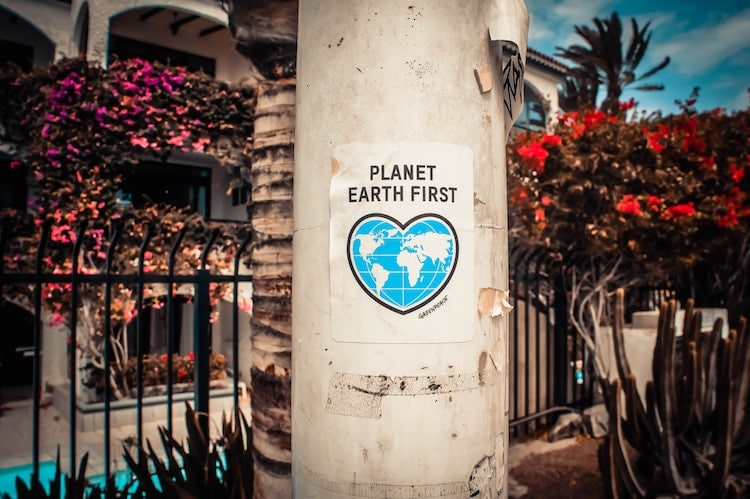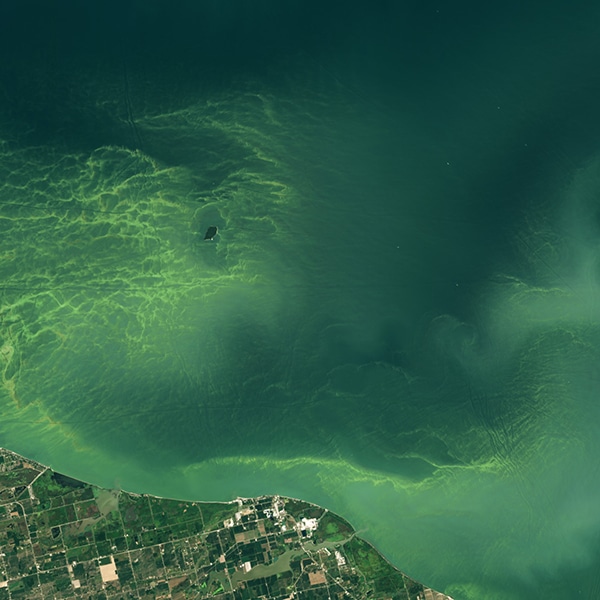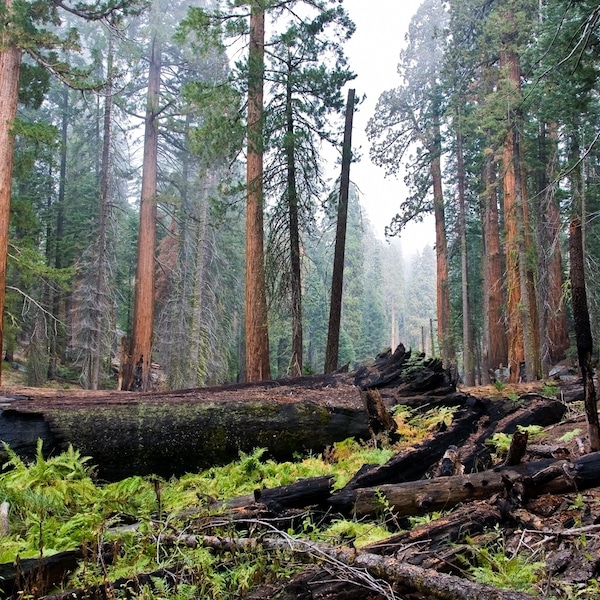After 11 years working with agencies, she began her own design studio in 2011. And since 2015, she's dedicated her career to studying how we can make an “eco-positive world” through our choices as designers and consumers. Her book, De Verborgen Impact (Hidden Impact), maps the environmental impact of the consumer, giving a large scale view in order for individual understanding of how each choice made contributes to the larger problem.
In her research, Porcelijn looks at everything from the global impact of importing and exporting to the environmental toll of producing single consumer items, such as a laptop computer. Her “Impact Top 10” breaks down, with surprising results, the average items used by consumers that cause the largest amount of environmental impact. Who knew that meat would come in second, beat out only by consumer products, but well above cars? (If you speak Dutch and want to understand your individual impact, answer a few questions to see how you compare to others.)
We had a chance to speak with Porcelijn about her work and how she hopes her book can help create change both for consumers and designers. Read on for our exclusive interview.

How did the idea for your book come about and when did you start the research for it?
At the beginning of 2014, my husband Rick and I were at home sitting on the couch. The kids were out and we talked. He told me that the sixteen largest container ships emit as much sulfur as all the cars in the world together. I was surprised. When he told me that every day 27 million trees disappear, while trees remove CO2 from the air, I was shocked.
Rick had delved into it, and as he went on telling me more, my image of our world tilted. I thought we were doing a pretty good job here in the West, but at that moment I saw we just moved our impact out of vision, to the other side of the world.
The rich consumer buys a lot of products, but he does not see the impact the production of these goods has on the environment. How can you make sustainable choices if you don't know what’s going on? The decision was made in a split second: I'm going to do something about this!
What surprised you the most about your findings?
When I started to investigate, I was shocked to find out that often I couldn’t find answers to my questions. Even worse, sometimes there were no words to describe the things I wanted to talk about. The worst finding, perhaps, was the fact that there was no impact top 10 of the average consumer, including hidden impacts. This is the first thing we need to know if we’re going to effectively change our daily routines, right?

You found that importing and exporting goods is part of what causes the issue with products and their impact on the environment. Can you explain why this is and what solutions you see to solve the issue?
As Western consumers, we have more impact on the environment than we think. Not just at home or at the pump, but also on the other side of the world, by producing and transporting the things we buy every day. If you include this hidden impact you can change your everyday life more effectively. I investigated the hidden impact of our daily lives and my book provides the knowledge and tools to live an eco-positive life.
If we assess the impact of the consumer, we usually only consider environmental impacts caused by the use of a product. Furthermore, we mainly look at climate effects, but if we solve the climate problem, and we don’t solve problems like water scarcity, pollution or plastic soup, then we still have a problem.
Over the last few decades, rich consumer countries have moved much of their industry and agriculture to low-wage countries. Production comes with lots of impact on climate, nature, and environment. Rich countries import these products and this food and their consumers buy these. But we often leave the “hidden impact” out of the equation.

Why do you think it’s important, as a designer, to be aware of the environmental impact of consumer goods?
Designers can make a big difference in many ways. First, we are beginning to understand what we should NOT do anymore—and Hidden Impact reveals that thoroughly—but the next question is, what to replace the fulfillment of our needs in a sustainable way? What SHOULD we do? And that is a design challenge! I think we need to work together with scientists to come up with the best solutions.
Second, we are trained systems thinkers, and the world needs those—product designers can design circular products, and circular business models, while product designers and architects can design for long endurance products, with renewable materials and design for disassembly and reuse.
We could take responsibility for the products we put in the world; do we want to add more stuff people don’t really need into the world, while it damages the environment and brings our joint future in jeopardy, while the ones who benefit have commercial motives instead of humane motives? Also, design for communication: tell the world what’s at stake and what we can do about it, inspire them with awesome alternatives which are more attractive than our current ways
In short, we need nothing short of a paradigm shift and we need designers to make it a good one. Eco-positive and fair.

How has your research been received thus far?
When I started out, I thought nobody would be interested in a book about the environment. But I really wanted to make this book because I thought it was important, so I made the book I wanted to make. Along the way, I received a lot of positive feedback and since publication in Holland, things have gone crazy!
We’ve already sold over 5,000 copies in Holland, and today I’ve sent the fourth edition to the publisher. My inbox overflows with requests for an English version and I’m working on the U.S. edition—still looking for a publisher in the U.S. though.
I was in Brazil last week, and there it was received with enthusiasm: I was on Globo (biggest national network), headlines on BBC Brazil and Casa Vogue, etc. In Holland, I’m fully booked for lectures and interviews. All these things are great, and at the same time, I’m a bit worried, because when am I going to find the time to write my next book?

How do you hope your findings are used by the public?
The best thing that can happen—and it does, people tell me—is that people actually change their lifestyles. I will never tell people what they should or shouldn’t do. I merely help those who want to make effective changes to improve their environmental impact. And I hope to inspire people as a side-effect of my research.

Some of the biggest issues you mention, like microplastics, come from items like car tires. With this being such a common item, do you know of any companies working on alternative solutions?
It is a common item, but it isn’t common knowledge yet. Nevertheless, I’ve heard about research for better tire materials, but that’s difficult to tackle since biodegradable plastics in nature aren’t as biodegradable as in the lab. We could catch run-off from the roads and clean it, and we could choose a different means of transportation (bike, walk, and public transit).

Aside from a U.S. edition, do you plan on having your book released in other languages as well, to reach an even wider audience?
Oh yes, for sure! If we want to save the world, we need as many people on board as possible. Especially in rich consumer countries, which have—on average—the biggest impact. In the twelve biggest economies in the world lives 13% of the world population, but we cause 55% of the impact! That means that with 13% of the people, we can reduce over half the impact, and that’s a hopeful thought to me.

What would be your message to consumers about the impact their choices have on the environment?
We, consumers, are key. Ultimately, we decide everything that’s going on in the world, even though we often don’t realize it. We buy products and with our money, companies thrive. They can either damage or save the environment, and we get to choose which ones survive by buying their stuff. We decide who our politicians are and what they will fight for. The more money you have, the more difference you can make, either by your lifestyle and daily habits or by devoting yourself as a professional to for an eco-positive society*.
[Eco positive: when you (or a company, or a city/country etc) have a more positive impact on the environment than negative, harmful impact. Protecting and restoring nature, working on family planning and reducing population growth, designing sustainable or eco-positive solutions, cleaning up pollution etc.]
Any upcoming projects or further research you’d like to share?
Yes, I’m hoping to start working on my next book soon, because I’m curious what the best possible (feasible) future would look like. I want to put an attractive dot on the horizon!
Babette Porcelijn: Website | Twitter
My Modern Met granted permission to use photos by Babette Porcelijn.
Related Articles:
Eye-Opening Landscape Photos Explore the Environmental Cost of Human Impact
Mermaid Swims in a Sea of 10,000 Bottles to Spotlight Plastic Pollution
Eco-Friendly Logo Redesigns Promises to Save Millions a Year in Printing Costs
Interview: Photographer Travels to Alaska and Discovers Polar Bears Living With No Snow























































































